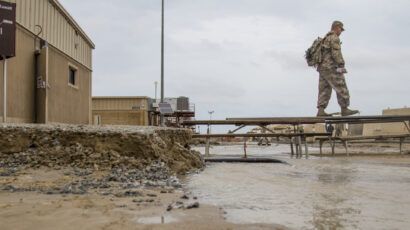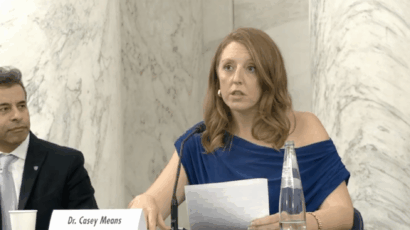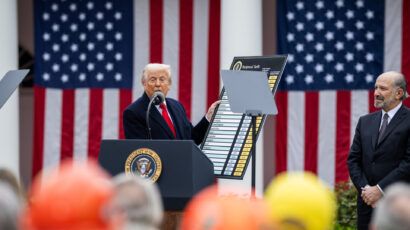It’s smart to scale back nuclear weapons spending
By Kingston Reif | May 20, 2013
As part of his effort to win Republican support for the New Strategic Arms Reduction Treaty (New START) in 2010, President Obama submitted to lawmakers a 10-year plan to maintain and modernize US nuclear warheads, strategic delivery systems, and their supporting infrastructure. Contained in what is known as the "Section 1251 Report," the latest public version of the plan outlines $88 billion in projected spending on the National Nuclear Security Administration's (NNSA) weapons activities and $125.8 billion for strategic delivery vehicle modernization at the Pentagon between fiscal years 2012 and 2021.
Three years later, the administration's budget request and Congressional appropriations for nuclear modernization, though staggering in their size, have not kept pace with the plan. This has prompted two leading senators, James Inhofe, the top Republican on the Armed Services Committee, and Bob Corker, the top Republican on the Foreign Relations Committee, to cry foul. In recent opinion pieces in the Wall Street Journal and Foreign Policy, Inhofe and Corker allege that the administration has broken a sacred vow, and that having done so will make it nigh impossible for the President to get Senate approval for further nuclear reductions in the future.
The holes in this depiction of events are large enough to contain a nuclear explosion. The claim that the administration has reneged on its nuclear modernization commitments is specious for numerous reasons. More important, the insinuation by Inhofe and Corker that nuclear weapons should be exempt from budget reductions ignores the realities of the new fiscal environment, as well as the diminished role these weapons play in US security policy.
Let's start with the argument that funding for the nuclear weapons complex — specifically the NNSA's nuclear weapons budget — is inadequate. First, the cuts to this budget have been spearheaded by the Republican-led House, not the administration, a reality that Inhofe and Corker conveniently fail to mention. The two Senators suggest that the President should be able to wave a magic wand and convince Republican appropriators to fund what they don't want to fund.
In addition, the original 2010 nuclear spending plan referenced by Inhofe and Corker was crafted before Congress approved the bipartisan Budget Control Act, which requires reductions in the projected growth of defense spending and could lead to even larger cuts if sequestration is implemented for the long-term. Despite the tough budget environment, the administration's request for fiscal 2014, released in April, includes an increase of more than 7 percent above the previous year's level and nearly $1.5 billion more than Congress spent on weapons programs in fiscal 2010.
The main difference between the original spending plan and the current budget is the absence of funding for the construction of a new multi-billion dollar plutonium facility at Los Alamos national laboratory in New Mexico. Inhofe and Corker attack the administration's decision to delay the facility by at least five years, but they ignore the fact that essential plutonium capabilities can be maintained in the near term using existing facilities, for a fraction of the cost. This explains why both the Senate and House appropriations committees supported the decision to delay the facility.
Inhofe and Corker's argument that the budget to sustain and modernize nuclear delivery systems is insufficient also falls flat. For example, they bemoan the schedule for the program to build 12 new ballistic missile submarines, which the Pentagon delayed by two years in last year's budget request. But the Navy believes that the delay is manageable and necessary to put the replacement program on a more stable and predictable footing. Meanwhile, the Pentagon continues to spend billions to modernize existing delivery platforms.
Inhofe and Corker's misrepresentation of the administration's record on nuclear modernization would be bad enough on its own, but it also speaks to a bigger problem with how they view the role of nuclear weapons in the current security and economic environment.
US nuclear weapons policy has been on autopilot since the end of the Cold War. As former Vice Chairman of the Joint Chiefs of Staff James Cartwright likes to say, when it comes to nuclear weapons, America still hasn't decided what it wants to be when it grows up. The current US arsenal of approximately 5,000 nuclear warheads and more than 800 missiles and bombers is but a pared-down version of its Cold War-era predecessor. The United States still configures its forces to allow it to conduct a disarming first strike against Russia's similarly configured nuclear arsenal.
While the world has changed, this outdated thinking continues to dictate nuclear spending decisions. Over the next 20 to 25 years, the Defense and Energy departments plan to spend more than $100 billion to build 12 new ballistic missile submarines, $68 billion on a new generation of nuclear-capable long-range bombers, $10 billion to refurbish the B61 nuclear gravity bomb, and perhaps additional billions to replace or modernize other delivery systems and warheads. If pursued to completion, these spending plans will suck funding from higher-priority security programs and could saddle the United States with an outsized and ill-suited nuclear arsenal for decades to come.
The prospect of $1 trillion in defense spending reductions over the next decade due to the Budget Control Act is putting intense pressure on the administration to adjust its current spending trajectory. In addition, the President finally appears poised to make some long-awaited nuclear policy decisions that could pave the way for further reductions in the size of the arsenal. Further nuclear cutbacks won't eliminate the need for continued expenditures on nuclear weapons, but a smaller arsenal could save billions, and every billion counts in a time of budget austerity.
Against this backdrop, protecting nuclear weapons at all costs, as Inhofe and Corker recommend, is strategically counterproductive and fiscally unsustainable. Decisions about the future of the deterrent must be made on the basis of need and affordability — not fealty to a spending plan hashed out for political reasons nearly three years ago. If security requirements change, the 10-year nuclear weapons program ought to change accordingly. And even if requirements remain the same, given the stressed budget environment we should still be searching for less-expensive alternatives to meet deterrence needs. Otherwise funding for nuclear weapons will crowd out more essential programs, both within the weapons budget and elsewhere. For instance, while the fiscal 2014 request for the NNSA weapons budget rose by 7 percent, the request for the NNSA's core nuclear and radiological security initiatives, which aim to ensure that terrorists don't get their hands on dangerous materials, was reduced by a whopping 15 percent. Whatever one thinks about the spending plan worked out in 2010, funding nuclear weapons at the expense of vital threat-reduction programs is unacceptable.
Bringing policy in line with the fact that nuclear weapons play a fading security role would allow for significant changes to the US arsenal, and by extension, significant budget savings. Savings could even be found without reducing the arsenal below the New START level of 1,550 deployed strategic warheads and 700 deployed delivery systems, which should be appealing to fiscally hawkish Republicans. The decision to delay the plutonium facility at Los Alamos was one such example. Another option for savings is the B61 life-extension program, the cost of which has ballooned from $4 billion to $10 billion in just two years. In a recent congressional hearing, Sen. Dianne Feinstein, a California Democrat, said the NNSA had considered but rejected a less-ambitious approach that could extend the life of the nuclear gravity bombs until at least the early 2030s for only $1.5 billion, or 85 percent less than the currently proposed program.
Inhofe and Corker may find it politically expedient to attack the administration for failing to come up with every single penny of what they believe was promised in 2010. But instead of quibbling about a few billion dollars over 10 years out of a total annual nuclear weapons budget of some $31 billion, both the Senate and the administration ought to ask whether it makes sense to lock in policies that guided us during the first 60 years of the nuclear age for the first 60 years of the 21st century.
Together, we make the world safer.
The Bulletin elevates expert voices above the noise. But as an independent nonprofit organization, our operations depend on the support of readers like you. Help us continue to deliver quality journalism that holds leaders accountable. Your support of our work at any level is important. In return, we promise our coverage will be understandable, influential, vigilant, solution-oriented, and fair-minded. Together we can make a difference.
Topics: Columnists















